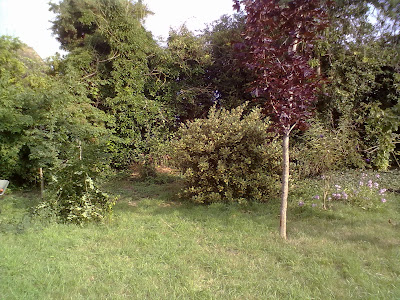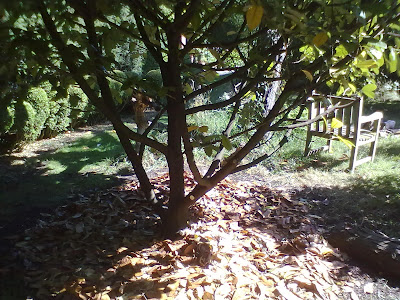It's lovely to see how much interest this whole scythe thing is generating, I wish I'd started writing about it earlier!
Today - equipment.
I have an Austrian scythe, so if you have something other than that, this might not apply to you: and if you are still thinking about getting a scythe, then I would strongly recommend the Austrian scythe, it's light, well balanced, and easy to use.
I bought mine from Simon Fairlie at
The Scythe Shop, (I do like a website that says what it does) and he supplies a good package of information, both on his website and with the documentation accompanying your new scythe.
Right, scythe equipment.
The first thing I bought was a long canvas bag, in which to carry the blade and all the odds and ends which I think are necessary and/or useful. After a few times, I found that the odd bits of equipment were a bit lost inside what is quite a big bag - and also, early on, I nearly lost my whetstone and holder because I had left them on a fence post to dry before I packed them away... and yes, I walked off without them and had to tear back at top speed before they disappeared!
So I made myself a Scythe Tool Roll with a pocket for each item:
Here it is, showing you what it contains. From the left, there is the lower handle, then the upper handle, the sheath (I have the copper one, as you can see), the whetstone for honing, a spanner for tightening handles, and the allen key for tightening the blade holders.
Then there is a small handful of "spares" which I thought was sensible - I haven't yet dropped one of the small washers or nuts onto long grass
and been unable to find it again, but I can see it happening one day - and the wooden wedge, which I don't use at this time, but I might need it one day, when my style improves.
Here - right - is the tool roll with everything tucked in place.
There is a small pocket on the lower right-hand corner for the washers, nuts and wingnuts, and a slit for the wooden wedge.
The top flaps down to cover the pockets, which keeps everything in place
and helps prevent them rubbing against each other in transit.

I then roll it up from the right-hand side into a slightly lumpy bundle...
...which is then easy to pick up and transport.
here you go, nice handy size.
Out in the field, every pocket should be filled, so if at the end of a
session there is an empty pocket... well, we know what that means!
("turn around, go back and look for whatever is missing!")
So far this has proved to be a good philosophy, as there have been several occasions where I've put something down and not realised it: the sheath and the whetstone are the worst for nearly being left behind!
The best thing I was given was a plastic scythe cover, made for me by my
friend Jim, who got me interested in scything last year. This makes it a
great deal easier to move it around!
Here it is - very simple,
just a piece of stout plastic sheet, bent over and fastened with rivets.
The blade curls neatly inside it, and there is a lovely low-tech shoe-lace at the end for tying round the blade.
Here's the cover with the blade part-way out, to show you.
Being somewhat curved, the cover has to be wide enough to accommodate the whole thing.
It is deliberately oversized, so that the blade has plenty of room to dry, and doesn't "sweat" inside it.
I have heard tales of the canvas covers absorbing water and causing - sharp intake of breath - rust!!!
So I'm very happy to have nice wipe-clean plastic covers, that don't encourage rust!
Finally there is the bag itself: it cost a few pounds from an Army and Navy Surplus store, and is pretty cheap and cheerful - no pockets, nothing fancy, just a plain long bag with a zip.
Here it is stuffed ready for action - the scythe blade in its cover just fits nicely inside the bag.
I felt a bit of a fool going round the shops with a tape measure, but it was worth it to get something long enough that no part of the blade - covered or not - sticks out.
In case you wondered about the contraption on the end, I added a couple of webbing straps, to hold a couple of water bottles.
You need water for the whetstone, hence the old milk carton (the lids live inside the bag when not in use, so the bottles stay fresh) and I generally get quite thirsty when working outside, so I take a bottle of water to drink, as well.
Yes, I suppose I could just take two ordinary bottles of water... maybe my tidy mind likes to have one of "dirty" water, which can be refilled at water butts if necessary, and one of "clean" water to drink. Anyway, there they are: I found that inside the bag, they tended to fall over and sometimes leak, so it seemed easier to hang them on the outside where they stay upright.
As well as taking the tool roll and the blade, I take along an old pair of gloves, one of which (the right hand one) is stuffed into my pocket when working, so that I can pull it out for honing.
I take both of them, in case I feel the need to wear gloves - but mostly I enjoy the luxury of being able to work bare-handed.
The WD40 is used at the end of the day, once I've wiped off the grass from the blade and let it dry, I give it a squirt and put it in the cover for transport home.
And the first aid kit? Oh, I'm a big believer in "better to have it and not need it, than the other way round" so I assembled a kit which includes sticky plasters, antiseptic wipes, scissors, tweezers (for splinters), steri-strip "stitches" in case of slashes; odd dressings and micropore tape, a small tube of savlon, same of antihistamine cream for insect bites: a bandage, some eye-flush (you never know...) and anything else I think might be useful.
So far, the only injury I've had has been a major slash from brambles in the hedge, nothing to do with the scythe at all: and that's how I hope it will stay.
But it's good to be prepared.
So there you go, that's my Scythe Equipment bag: all I have to do is put in the blade, pick up the handle, fill up the water bottles, sling it on my shoulder and off I go, quite self-contained.















